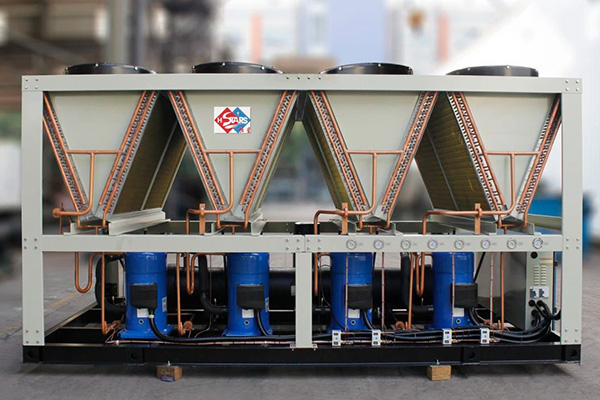In the world of industrial cooling, scroll air-cooled chillers are spearheading an energy-efficiency revolution. Among them, the newly launched 800kW chiller by H.Stars Group has quickly become a topic of industry discussion. But what qualifies as a “large-scale” unit in this field? Let’s decode the standards of industrial chiller classification from a technical perspective.

1. Understanding Chiller Size Classifications
In the HVAC industry, the size of a chiller is defined by more than just its physical footprint. According to ASHRAE (American Society of Heating, Refrigerating and Air-Conditioning Engineers), scroll air-cooled chillers can be categorized by cooling capacity as follows (for reference):• Small Units: <200kW
• Medium Units: 200–500kW
• Large Units: >500kW
This classification considers system integration, efficiency curves, and actual application environments—not just output power.
International giants like Trane and Carrier follow similar sizing logic. 500kW often marks the dividing line between commercial and industrial systems. Units above this threshold typically feature multiple compressors, subcooling technology, and advanced industrial-grade designs—with COP (Coefficient of Performance) values exceeding 3.8 and meeting China's GB19577-2015 first-level energy efficiency standard.
2. Where Does the 800kW Unit Stand?
H.Stars’ 800kW scroll chiller features a dual-rotor variable frequency compressor system and sits firmly in the upper tier of industrial cooling. Compared to conventional 500kW models, it reduces metal consumption per kilowatt of cooling by 18% and boosts its IPLV (Integrated Part Load Value) to 4.2. This translates to an annual power saving of approximately 120,000 kWh based on 3,000 operating hours per year.In field testing at a cold chain logistics center, the unit maintained full-capacity operation even in harsh 45°C ambient conditions—demonstrating excellent environmental adaptability.
3. Compact Design Meets High Power
Compared with McQuay’s MWC 650kW chiller (5.2m² footprint), the H.Stars 800kW unit achieves higher capacity while maintaining a smaller footprint (4.8m²). This compact modular design simplifies transportation and installation.Its smart multi-unit control system supports parallel operation of up to 8 units, enabling a combined capacity of up to 6400kW. This makes it a perfect fit for large-scale data centers, chemical processing plants, and industrial manufacturing facilities.
4. Market Trends: Big Units, Bigger Opportunities
With the rise of China’s “New Infrastructure” initiative, demand for high-capacity chillers is surging. As of 2022, chillers over 500kW now account for 38% of the market—up from just 23% five years ago.These systems are essential in semiconductor fabs and battery manufacturing lines. For instance, after a major lithium battery producer adopted the H.Stars 800kW chiller, their cooling energy consumption dropped by 31%, while product yield increased by 2.7%.
5. Smart Cooling for Industry 4.0
To meet the demands of intelligent manufacturing, H.Stars integrates IoT-based remote monitoring into its chillers. Each unit tracks 132 real-time operational parameters. Combined with machine learning algorithms, the system optimizes energy use dynamically, transforming the 800kW chiller from a mere cooling unit into a critical node in the industrial IoT ecosystem.As Industry 4.0 accelerates, the emergence of H.Stars’ 800kW scroll chiller redefines what a large-scale cooling solution looks like. It's more than a machine—it's a symbol of China’s rising capability in precision industrial refrigeration, and a gateway to a smarter, more efficient future.
When cooling capacity crosses new thresholds, what follows is not just power—but an entire shift in the energy efficiency paradigm.

评论
发表评论